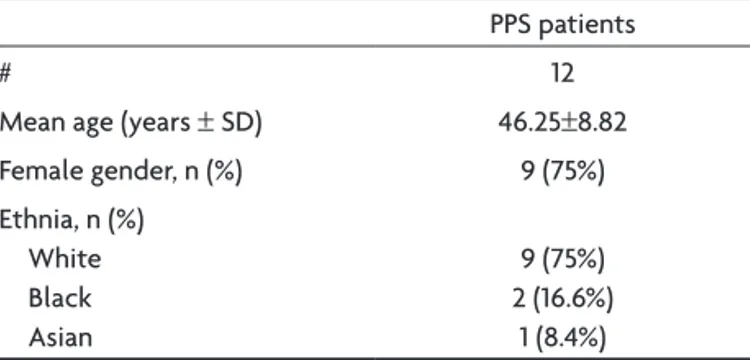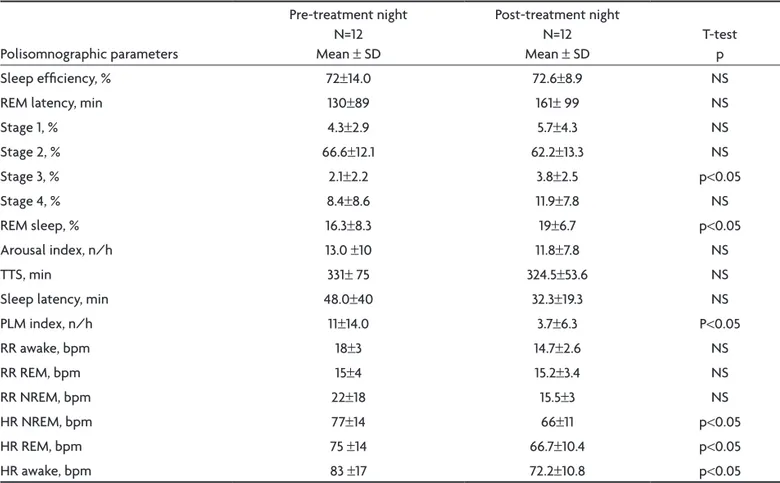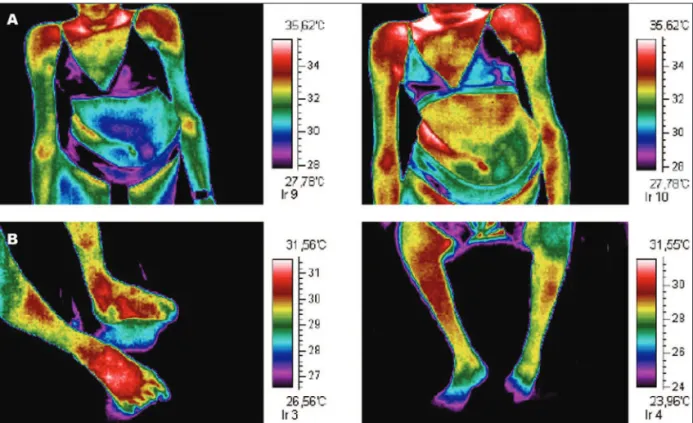Arq Neuropsiquiatr 2009;67(4):1049-1053
EffEcts of thE usE of MIG3 bIocEraMIcs fabrIcs
usE – lonG InfrarEd EMIttEr – In paIn,
IntolErancE to cold and pErIodIc lIMb
MovEMEnts In post-polIo syndroME
Tatiana Mesquita e Silva
1, Gustavo Antonio Moreira
2, Abrahão Augusto Juviniano Quadros
1,
Márcia Pradella-Hallinan
2, Sergio Tuik
2, Acary Souza Bulle Oliveira
2abstract – The main post-polio syndrome (PPS) symptoms are new-onset weakness, new-onset atrophy, fatigue, cold intolerance, and pain associated with sleep disturbances. The polysomnographic study is the gold pattern to analyze sleep disorders. Objective: To assess pain, intolerance to cold and periodic limb movements (PLM) index before and after the use of MIG3 bioceramic fabrics over 4 weeks. Method: 12 patients with PPS from UNIFESP/EPM. All patients were submitted to polysomnography and infra-red examinations with answered scales of pain and intolerance to cold before and after the use of MIG3 bioceramics fabrics. Results:
There were significant decreases in pain and PLM index. Conclusion: MIG3 bioceramic fabrics can help in the treatment of pain and PLM in PPS patients.
KEy wordS: sleep, pain, post-polio syndrome.
Efeitos do uso de tecidos com biocerâmica MIG3 – emissora de infravermelho longo – na dor, intolerância ao frio e movimentos periódicos dos membros na síndrome pós-poliomielite
resumo – dentre as manifestações clínicas da SPP destacam-se nova fraqueza, fadiga, dor, intolerância ao frio, nova atrofia e transtornos do sono. A polissonografia de noite inteira permanece sendo padrão ouro para análise do sono e diagnóstico de transtornos do sono. Objetivo: Avaliar o comportamento da dor, intolerância ao frio (IF) e índice de movimentos periódicos de membros (PLMs) após uso de colchonete e roupas com biocerâmica MIG3 por 4 semanas. Método: 12 pacientes com SPP, da UNIFESP/EPM. Todos realizaram exames de polissonografia e infravermelho e responderam a questionários de dor e IF antes e após o uso dos materiais. Resultados: Houve diminuição significativa da dor e dos PLMs. Conclusão: os tecidos com biocerâmica MIG3 podem ser um coadjuvante ao tratamento da dor e dos PLMs nos pacientes com SPP. PALAvrAS-cHAvE: sono, dor, síndrome pós-poliomielite.
Universidade Federal de São Paulo (UNIFESP-EPM) [Federal University of São Paulo], São Paulo SP, Instituto do Sono [Sleep Institute], São Paulo SP, Brazil: 1Master in Health Sciences; 2Md, Phd.
received 6 May 2009, received in inal form 5 August 2009. Accepted 6 August 2009.
Dra. Tatiana Mesquita e Silva – Av. Rebouças 1278 / 1002 - 05402-000 São Paulo SP - Brasil. E-mail: tatimsilva@gmail.com Poliomyelitis is a viral disease that is typically
pres-ent during the biphasic phase, with headache, fever and gastrointestinal symptoms, followed days later by impair-ment of the motor neurons of the spinal cord, which may lead to paralysis, usually involving lower limbs in an asym-metrical and non-proportional way1. Post-polio syndrome
(PPS) is characterized by the development of new neuro-muscular symptoms that occur after a stability of at least 15 years in patients with previous acute polio paralysis. These symptoms include: (1) new onset of muscular
weak-ness and new onset of limb and bulbar or respiratory mus-cular atrophy [post-polio musmus-cular atrophy (PPMA)], and (2) excessive fatigue and diminished physical resistance. Besides these symptoms, joint and muscle pain, intoler-ance to cold and sleep disturbintoler-ances (obstructive and cen-tral apneas, periodic limb movements – PLM) frequent-ly occur. PPS is a clinical diagnosis that requires exclusion of other clinical, neurological, orthopedic or psychiatric illnesses that could account for the new symptoms2. PPS
pe-riod higher than 15 years, which may represent up to 70% of acute paralytic polio survivors3-5. Sleep disturbances
have been described alongside PPS for decades. Usually, periodic limb movements occur during the irst hours of sleep. The movements include feet dorsal lexure and tri-ple lexion of lower limbs6,7. Patients who experience PLM
report paresthesias from calves to thighs, with arms being rarely involved. The symptoms are usually symmetrical-ly and bilateralsymmetrical-ly reported. This feeling can be felt inside the leg and can be described as sliding, dragging, discom-fort, restlessness or nervousness7,8. The patient may
pres-ent a long asymptomatic period. depression and sleep disturbances are resulting elements7-9. The prevalence in
the general population is around 5%. Period limb move-ments during sleep are an independent nosological enti-ty. These episodes occur more frequently in the irst half of the night and provoke arousals from sleep. They lead to sleep fragmentation, unrefreshed sleep and daytime hyper somnolence8,10.
In the healthcare ield, the effects of luminous radi-ation on the tissues are well known. Through the action of visible (red) or invisible (infrared) light, luminous radi-ation promotes a molecular vibrradi-ation, leading to an in-crease in the tissue metabolism, called biostimulation. ra-diation acts by increasing the cell membrane permeabil-ity, favoring the exchange of metabolites as extracellu-lar medium, and by nurturing the cells. It acts on the mi-tochondria, favoring the ATP synthesis and, consequent-ly, stimulating the synthesis of proteins such as collagen and elastin. It also enhances cell division. In order to pro-voke this increase in metabolism, the extracellular medi-um is required to be healthy. Infrared stimulates chemi-cal mediators and hormones that will act on the control of edema, pH, oxygen free radicals and microcirculation, fostering the required conditions for the increase in the cell metabolism11,12.
MIG3 bioceramics, an infrared emitter, incorporated in clothes (gloves, shorts, dressings), allows its use at home, in a simple and non-invasive way, at work, and even during sleep, thereby facilitating a patient’s daily life. recent evi-dence claims that it can control pain, inlammation, accel-erate healing in the post-operative period, and minimize the use of drugs and its side effects, through self-regula-tion mechanism12-16.
The objective of this study is evaluate the impact of the use of MIG3 bioceramic over four weeks on pain, in-tolerance to cold and periodic leg movement in patients with post-polio syndrome.
MEthod
Twelve patients with post-polio syndrome from the Polio-myelitis and PPS outpatient clinic of the Neuromuscular diseas-es department of UNIFESP/EPM (Table 1) were evaluated
accord-ing to the Mulder post-polio syndrome criteria. These patients were asked to use MIG3 bioceramics fabrics (portable mattress, shirts, dressings and shorts) during 4 weeks.
The polysomnography exam was performed at the beginning of the treatment and soon after its end in our sleep institute.
The infrared exam was performed before the treatment on-set and soon after its completion, at the Nove de Julho Hospital, by a specialist in pain diagnostics. In order to perform the exam, patients had to stay in a air conditioned room during 30 min-utes, for stabilization of the body temperature, at 20oc and 55%
of air relative humidity, with an air speed lower than 0.2 m/s to prevent evaporation and subsequent skin thermal loss by forced convection, seated or standing, when possible, without clothes on the upper and lower body parts (only underwear), for the sta-bilization of the cutaneous body temperature.
Long hair was tied back to avoid image interference. during the period in which they were sat or remained standing, the pa-tient was not allowed to touching his/her trunk with the hands or any other surface.
Subsequently, by infrared images of anterior, lateral, posteri-or and oblique incidences were obtained, hposteri-orizontally position-ing the infrared camera at a 1 meter distance and vertically ad-justed in horizontal line with the patient’s body.
The Ir images were captured by the infrared sensor of 160 × 120 resolution with 20o lenses. The thermal sensitivity employed
was 0.1oc by color shade, using a rain-type colorimetric scale
(palette). The colors are, from warmer to colder, white, pink, red, orange, yellow, light green, dark green, light blue, dark blue, pur-ple and black, directly indicating the distribution level of local cutaneous blood perfusion. All images were exposed with the palette side by side for consulting reasons, when comparable within the same upper and lower temperature thresholds.
Pain and intolerance to cold were quantiied through ana-logical visual scales (AvS).
Statistical analysis
data were analyzed comparing the average temperature val-ues in T0 and T4, looking for a evidence of MIG3 fabrics use. The bimodal pared t-test was used for an α error of 0.05. There were also evaluated the AvS values and polysomnographic parameters before and after the use of MIG3 fabrics using respectively chi-squared test and pared t-test (considering p<0.05 and α=0.05).
Table 1. Demographic data.
PPS patients
# 12
Mean age (years ±Sd) 46.25±8.82
Female gender, n (%) 9 (75%)
rEsults
we found a signiicant decrease in pain intensity (8.3±2.5 vs. 3.8±2.5). A slight non-signiicant decrease in intoler-ance to cold was also observed (6.4±2.3 vs. 5.3±2.4) (Fig 2). The polysomnographic exam demonstrated a cant decrease in the PLM index (11±14 vs. 3.7±6.3), a signii-cant decrease in the heart rate (Hr) during wake (83±17 vs. 72.2±10.8), rEM sleep (75±14 vs. 66.7±10.4) and non-rEM (77±14 vs. 66±11) sleep periods (Table 2).
The infrared exam did not show a signiicant decrease in the subcutaneous temperature range after the use of fabrics with MIG3 bioceramics; however, there was an im-provement in intolerance to cold clues and complaints of pain (Fig 2).
dIscussIon
The radiation emitted by long infrared (LIr) fabrics in-creases membrane permeability and the calcium concen-tration in the cell membrane and cytoplasm; it biological-ly stimulates the cell, favoring the exchange of metabo-lites within the extracellular medium, nurturing the cell. It also acts on mitochondria, promoting the ATP synthe-sis used in muscular contraction16.
The muscle-skeletal system is also beneited by the ef-fects of LIr, so that its application promotes a decrease in muscle spasms, as well as muscle relaxation. The met-abolic rate may suffer an increase of about 13% for each rise of 1oc in the tissue temperature, and the increase in
metabolism will be higher in the region where most of the heat is generated. As a result of this, there is a high tis-sue demand for oxygen and nutrients, resulting in an in-crease in the catabolic products clearance17 and in
stimu-lation for substance release, such as endorphins and en-docephalines which are provided with analgesic proper-ties similar to those of morphine18. due to these
analge-sic properties of MIG3 bioceramics, long infrared emitter,
Table 2. Sleep quality.
Polisomnographic parameters
Pre-treatment night N=12 Mean ± Sd
Post-treatment night N=12 Mean ± Sd
T-test p
Sleep eficiency, % 72±14.0 72.6±8.9 NS
rEM latency, min 130±89 161± 99 NS
Stage 1, % 4.3±2.9 5.7±4.3 NS
Stage 2, % 66.6±12.1 62.2±13.3 NS
Stage 3, % 2.1±2.2 3.8±2.5 p<0.05
Stage 4, % 8.4±8.6 11.9±7.8 NS
rEM sleep, % 16.3±8.3 19±6.7 p<0.05
Arousal index, n/h 13.0 ±10 11.8±7.8 NS
TTS, min 331± 75 324.5±53.6 NS
Sleep latency, min 48.0±40 32.3±19.3 NS
PLM index, n/h 11±14.0 3.7±6.3 P<0.05
rr awake, bpm 18±3 14.7±2.6 NS
rr rEM, bpm 15±4 15.2±3.4 NS
rr NrEM, bpm 22±18 15.5±3 NS
Hr NrEM, bpm 77±14 66±11 p<0.05
Hr rEM, bpm 75 ±14 66.7±10.4 p<0.05
Hr awake, bpm 83 ±17 72.2±10.8 p<0.05
the signiicant improvement in pain complaints can be ex-plained in patients assessed.
The main effects of long infrared include improved circulation, increased immunity, repair and regeneration of tissues and the regulation of body luids (humoral sys-tem). The rise in body temperature and increased mobili-ty of body luids14, in addition to pain relief, are also some
consequences of LIr15. A signiicant improvement of
in-tolerance to cold was expected in patients with PPS due to enhanced circulation, but this improvement may not reached due to peripheral muscle atrophy, but also to im-pairment in the body temperature regulatory centers of the central nervous system.
This study demonstrated that the use of fabrics im-pregnated with MIG3 bioceramics, when in contact with the skin during the sleep period, can alter sleep quality.
we found that there was a signiicant improvement in PLM and Hr indexes during periods of wakefulness, rEM and NrEM sleep after a month of use of mattresses it-ted with MIG3 bioceramics.
The most accepted cause for the occurrence of PLM is that there is a change in the production of dopamine, provoked by iron deiciency. Patients with PPP have a PLM index higher than the general population and in a higher frequency, perhaps due to injury of neurons in the brain-stem or even of the motor neurons in the anterior horn of the spinal cord.
The MIG3 bioceramics in contact with the skin is known to produce a vasodilatation of arteries that irri-gate the skin and muscles, facilitating the venous return, and reducing the cardiac pre-load. This goes some way towards explaining the signiicant decrease in the heart rate before and after the use of fabrics impregnated with MIG3 bioceramics.
Studies performed in 1988 with the use of LIr showed improvement in the quality of sleep in patients and rats12.
In 1995, studies conirmed that LIr therapy lead to an im-provement in the quality of life, quality of sleep and general well-being of patients with chronic fatigue syn-drome13. These factors may result from the increase in the
brain temperature associated with the type of neuronal activation, characteristic of sleep in the hypothalamus and brainstem. The central nervous system excitation is reduced by increasing the blood temperature in the hypo-thalamus; resulting in a somniferous effect. The improve-ment in the symptoms is believed to be caused by the re-duction in pain and improvement in sleep13.
To conclude, the use of fabrics and mattresses itted with MIG3 bioceramics, a long infrared emitter, over four weeks, had signiicantly reduced complaints of pain and improved sleep quality. There was also a signiicant reduc-tion in PLM and heart rate indexes. Future studies should aim at enhancing our current data base on this exciting research area.
rEfErEncEs
1. Oliveira ASB, Maynard FM. Síndrome pós-poliomielite: aspectos neu-rológicos. São Paulo: Rev Neurociências 2002;10:31-34.
2. Dalakas MC. Post-polio syndrome 12 years later. In: The post-polio syn-drome: advances in the pathogenesis and treatment. Ann NY Acad Sci 1995;753:11-18.
3. Halstead LS. Managing post-polio: a guide to living well with post-po-lio syndrome. Arlington VA. ABI Professional Publications, 1998. 4. Mulder DW. Post-polio syndrome: Past, present and future. In: Munsat
TL (Ed). Post-polio syndrome: past, present and future. Boston: Butter-worth-Heinemann, 1991:1-8.
5. Maynard FM, Headley JI. Manual acerca dos efeitos tardios da po-liomielite, para médicos e sobreviventes. Associação Pós-Pólio de Por-tugal. Col “Rumos e Perspectivas”, 2000:1.
6. Martins PJF, Mello MT, Tuik S. Exercício e sono. Rev Bras Méd Esporte 2001:7;28-36.
7. Martinez D. Prática da medicina do sono. BYK 1999;1:276.
8. Montplaisir J, Laverdière M, Saint-Hilaire JM. Sleep and epilepsy: long term monitoring in epilepsy. EEG 1985:37(Suppl):S215-S239. 9. O’keeffe ST. Restless legs syndrome: a review. Arch Med Intern 1996:
156;243-248.
10. Ekbom KA. Restless legs syndrome. Neurology 1960:10;868-873. 11. Masuko AH, Prado LBF, Prado GF. Síndrome das pernas inquietas. Rev
Neurociências 2004;12:18-20.
12. Honda K, Inoué S. Sleep-enhancing effects of far-infrared radiation in rats. Int J Biometeorol 1988;32:92-94.
13. Masuda A, Kihara T, Fukudome T, Shinsato T, Minagoe S, Tei C. The ef-fects of repeated thermal therapy for two patients with chronic fatigue syndrome. J Psychosomatic Res 2005;58:383-387.
14. Inoue S E, Kabaya M. Biological activities caused by far-infrared radi-ation. Int J Biometeorol 1989;33:145-150.
15. Massayoshi Y, Takashi T. Far infrared- results and treatments for can-cer. Tokyo Joshi Ika Daigaku Medical University. Ed. Toppan Insatsu Kabushiki-Kaisha-Tokyo, 1989.
16. Toyokawa H, Matsui Y, Uhara J, et al. Promotive effects of far-infrared ray on full-thickness skin wound healing in rats. Exp Biol Med 2003; 228:724-729.
17. Kitchen S, Bazin S. Eletroterapia de Clayton. 10ª edição. São Paulo: Ma-nole, 1998.


